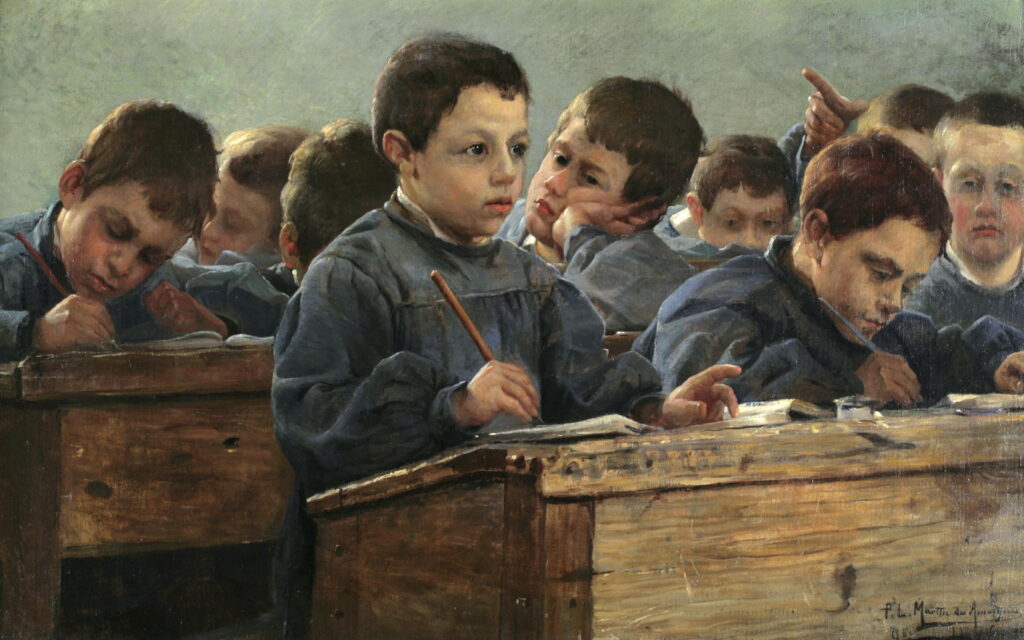Back to school: paintings 1860-1907

In the first of these two articles, I showed paintings illustrating school life from the early seventeenth century to the middle of the nineteenth, a period of more than two centuries when few artists painted the inside of the classroom. This changed from 1850, although the theme still failed to attract the best-known painters.
Albert Anker (1831–1910), The Village School in 1848 (1896), media not known, 104 × 175.5 cm, Kunstmuseum Basel, Basel, Switzerland. Wikimedia Commons.
Albert Anker, father of Swiss painting and known for his large output of ‘genre scenes’, probably painted more classrooms than any other. He painted The Village School in 1848 nearly half a century afterwards, in 1896, presumably from his own recollection of his final year at school in Neuchâtel. Compared to earlier paintings, this classroom is packed, relatively orderly, and well-equipped with benches and desks, even though the children are shabbily dressed, indicating their poverty.
Albert Anker (1831–1910), The School Exam (1862), oil on canvas, 103 × 175 cm, Kunstmuseum Bern, Bern, Switzerland. Wikimedia Commons.
Anker’s earlier painting of The School Exam from 1862 shows a more contemporary scene. It’s not clear whether the pupils are undergoing examination, or the school is. Three of them seen standing out at the front are so poor that they cannot afford shoes at all, but effort is at last being put into their education.
Winslow Homer (1836–1910), The Country School (A Country School-room in the Catskills, New England Country School) (1871), oil on canvas, 54 × 97.2 cm, Saint Louis Art Museum, St. Louis, MO. Wikimedia Commons.
Winslow Homer is perhaps the most famous painter to have made more than one work showing The Country School, believed to be of a country schoolroom in the Catskills, New England. This painting, dated 1871, is the first of a series of three or more showing the same largely empty classroom, with its impossibly wide age range. Two of the boys reading to the teacher are too poor for shoes, although the girls on the right look much better-dressed.
Following the collapse of the Second Empire during the Franco-Prussian War of 1870-71, the Third Republic targeted education for special development. Schools in France had earlier been largely run by the Catholic Church, but from 1833 communes had been required to provide schools for boys but not girls. The anti-clerical Minister for Public Instruction, Jules Ferry, introduced laws in 1881 to establish free education throughout the country, even for girls, and progressively replaced existing Catholic schools with the modern Republican School through the 1880s.
François Bonvin (1817–1887), The Scholar (1874), oil on panel, 35.5 × 26.3 cm, location not known. Wikimedia Commons.
François Bonvin’s The Scholar of 1874 is one of a few paintings showing individual pupils in the classroom. This boy has been granted the privilege of his own desk, at the front of the class, and is working on after the end of the school day. The teacher’s hat and coat are draped over his desk, ready for when this pupil completes his extra work.
Jean-Baptiste Jules Trayer (1824–1909), A Breton Infants School (1882), watercolour over pencil on paper, 68 × 83.8 cm, location not known. Wikimedia Commons.
Jean-Baptiste Jules Trayer’s wonderful watercolour of A Breton Infants School from 1882 predates any celebration of the Republican policy: the crucifix high on the wall at the right shows that this is one of the older Catholic schools. It shows a teacher helping one of her students with writing, in a class entirely wearing traditional Breton costume. There’s clearly room for improvement, though, as one girl is sleeping on her book, doubtless exhausted from her early morning work on the family farm.
Oscar Björck (1860–1929), Madam Henriksen’s School for Girls in Skagen (1884), media not known, 58 x 52.8 cm, Skagens Museum, Skagen, Denmark. Wikimedia Commons.
Rising standards of schooling were also reaching out to some of the more remote communities in Nordic countries. Oscar Björck’s painting of Madam Henriksen’s School for Girls in Skagen from 1884 shows a tiny and personal class in this small, isolated community at the northern tip of Jylland (Jutland), home to a major artists’ colony and birthplace of Danish Impressionism.
Then, in the mid 1880s, something remarkable happens to paintings of the schoolroom in France: they become strikingly photographic in their reality, with the advent of Naturalism.
Paul Louis Martin des Amoignes (1858–1925), In the Classroom (1886), oil on canvas, 68.5 × 110.5 cm, location not known. Wikimedia Commons.
Within two years of the early death of Jules Bastien-Lepage, Paul Louis Martin des Amoignes’ In the Classroom (1886) looks as if it may have been painted from photographs. One boy, staring intently at the teacher in front of the class, is caught crisply, pencil poised in his hand. Beyond him the crowd of heads becomes more blurred.
Jean Geoffroy (1853-1924), Primary School Class (1889), oil on canvas, 145 x 220 cm, Ministère de l’Education Nationale, Paris. Wikimedia Commons.
Jean Geoffroy’s Primary School Class from 1889 doesn’t give us the same depth of field effect, but shows one of the Republic’s new lay teachers working diligently in the classroom with her pupils. They’re still a bit of a shower, with the younger ones at the back working on traditional slates, but this is the public face of the modern Republican School.
Jean Geoffroy (1853-1924), In School (c 1900), further details not known. Wikimedia Commons.
In Geoffroy’s In School from about 1900, another lay teacher in a modern Republican infants class is caring for the French men and women of the future.
Nikolay Bogdanov-Belsky (1868–1945), Mental Arithmetic. In Public School of S. A. Rachinsky (1895), oil on canvas, 107.4 × 79 cm, Tretyakov Gallery Государственная Третьяковская галерея, Moscow, Russia. Wikimedia Commons.
Of course France wasn’t the only country to be improving its educational system at this time. Nikolay Bogdanov-Belsky’s Mental Arithmetic. In Public School of S. A. Rachinsky from 1895 shows a class of poor students in the village of Tatev in Smolensk province, at the western edge of the Russian Empire in central eastern Europe. They were fortunate enough to have a pioneering educator as their local teacher.
Sergey Rachinsky had been a professor of botany in Moscow until 1867, when he abandoned academic life to run the village school in Tatev. The elderly professor is seen with his students working on a challenging mental arithmetic problem. The teacher died in 1902.
Max Silbert (1871–1930), Singing Lesson in a School in Holland (1907), oil on canvas, 66 x 80 cm, location not known. Wikimedia Commons.
My final painting, by the Ukrainian artist Max Silbert, shows a Singing Lesson in a School in Holland in 1907, and is a fascinating chance discovery. Although its realism isn’t as detailed or photographic as the French paintings from the 1880s above, it shows a similar photographic depth of field effect. The pupils closest to the artist are shown in sharp focus, and those in the further distance are markedly blurred. It’s impossible to tell whether this results from Silbert painting this work from photographs with the same blurring, or it was a deliberate effect introduced by the artist to give it a photographic look.




